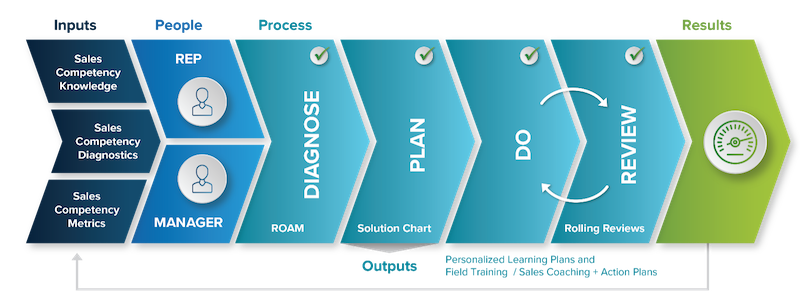Competencies are talked about in HR and talent circles, but less commonly in sales. In fact, competencies seem nerdy and confusing to many sales leaders. How do I know? Well, “nerdy and confusing” is a direct quote from a sales management workshop I ran. It was a good-natured, teasing comment, but there were a lot of heads nodding in the room.
In addition, I’ve seen both training and sales leaders struggle with these questions:
- Should we just teach a sales methodology that supports the sales process?
- Should we focus on the overarching sales competencies?
- Or should we somehow do both?
In this article, I’ll discuss the differences and dot connections between sales process, sales methodology and sales competencies, and then share how to use these elements to create a culture of coaching and a cadence of continuous improvement.
Let’s start with a reminder about sales process and methodology.
Sales Process
Sales Process includes the stages that a sale progresses through. It’s best to align your sales process with how your buyers buy, while also including things that your sellers must accomplish along the way. A well-constructed process includes objectives for each stage, tasks that must be performed in each stage, and exit criteria, or the things that must be completed in each stage to move forward. An example of sales process exit criteria would be meeting qualification criteria, or your contact agreeing to engage the other needed stakeholders to conduct a proper situation assessment (discovery).
Buyers have a process, too, even if it isn’t always clearly defined, aligned, or strictly followed. Buying process exit criteria (BPEC) are what each decision maker needs to see, hear, feel, understand, and believe in the current stage to feel comfortable moving forward to the next stage with you. I mention this because as part of each stage in the sales process, sellers must meet the (sometimes differing) exit criteria for each buyer. In essence, meeting the BPEC is one of the sellers’ exit criteria.
Sales Methodology
Sales methodology plugs into the sales process. It’s the buyer-facing selling tasks in each sales process stage – including the frameworks, models, steps and skills – that sellers use to navigate the buyer through their journey to a hopeful win. Going even further, buyers engage in a purchase pursuit for only a fraction of their time. A larger customer lifecycle starts before buyers enter a buying process and it continues after they purchase something. Smart sales leaders look at the entire customer lifecycle and ensure sales methodology elements span the lifecycle, not just lead generation and the sales process itself.
Sales Competencies
A competency model is a documented collection of the knowledge, skills, behaviors, traits and mindsets required to successfully perform a job. There are several levels and elements to competencies. Terminology varies, but this is how I frame it.
Blending Competencies and Methodologies
You probably already see the dot connection and “flashover point” between the sales competencies and the sales methodology. It’s the Methods that are used to execute the competencies. These frameworks, models, and skill steps allow for reps to develop repeatable, replicable skills that deliver predictable, scalable results. These methods fuel the tasks, which allow you to teach and develop competencies, to achieve the desired task levels, all seen in the table above.
A Cadence of Continuous Improvement
After teaching and effectively implementing your sales methodology, with its frameworks, models, and steps, sales competency assessments can sustain your methodology and help your sales force achieve mastery levels. Here’s how:
- Develop a competency assessment.
- Have your sales reps assess themselves.
- Have front-line sales managers assess their reps.
Use the data and the resulting conversations between the managers and their reps to generate and finalize personalized development plans for the reps.
Close competency gaps and improve methodology adoption and sales performance.
If you develop a rhythm for this, by implementing a coaching framework and re-assessing and establishing development plans every three to six months, you will establish a cadence of continuous improvement and put your sales force on a path to mastery and constant growth.

Learn More In a Free Webinar
To dive deeper into this topic, join Mike on Wednesday, October 20, at 2 p.m. Eastern for his webinar, How to Use Sales Competencies to Create a Cadence of Continuous Improvement.
Get our newsletter and digital focus reports

Stay current on learning and development trends, best practices, research, new products and technologies, case studies and much more.



